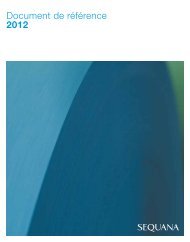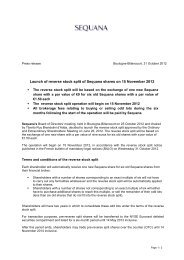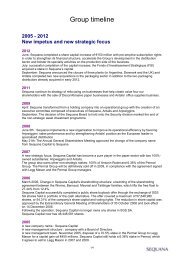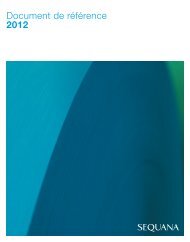Contents
Registration document PDF - Sequana
Registration document PDF - Sequana
You also want an ePaper? Increase the reach of your titles
YUMPU automatically turns print PDFs into web optimized ePapers that Google loves.
3Risk managementInternal control and risk management proceduresThe Internal Audit department comprises a team of auditors –mostly specialised in financial audits and audits of critical processes– backed up by external resources. The role of the InternalAudit department is to (i) provide an independent assessment ofinternal control at each level in the Group, (ii) assist the executivemanagement teams in assessing the effectiveness of their riskmanagement systems, (iii) verify that the procedures described arecorrectly applied, and (iv) ensure that any problems are resolvedand their causes eradicated. It is also responsible for regularlychecking that accounting procedures are correctly applied, monitoringthe overall internal control environment and ensuring thatrules on corporate ethics are respected. Centralising the internalaudit function has helped to streamline Group-wide audit plansand processes: once each mission has been completed, a reportcomplete with recommendations is sent to Group executive managementand to the executive management of the audited entity.The finance departments of Sequana and its subsidiaries – in liaisonwith the business managers in the subsidiaries – are in chargeof preparing budgets and financial projections, as well as individualand consolidated financial statements. They are also taskedwith overseeing the operations carried out by the Group as well aswith drawing up and relaying accounting procedures throughoutthe Group, and ensuring that these are correctly applied and thatthey comply with the laws and accounting standards applicable tothe preparation and publication of financial statements. In addition,the finance departments are responsible for publishing thefinancial statements on a timely basis.The Financing and Treasury Management department managesthe Group’s finance and cash resources. It is tasked with trackingthe Group’s liquidity position and with structuring and negotiatingits financing arrangements (financing lines, factoring agreements,etc.). It uses financial forecasts and weekly cash reports tocoordinate financing of the operating subsidiaries and the transferof any surplus cash to the appropriate holding company via currentaccounts or lending/borrowing arrangements. As stipulatedin the different financing agreements, there are no cash poolingarrangements between Antalis, Arjowiggins and Sequana.The Financing and Treasury Management department is also incharge of hedging foreign exchange and interest rate risk for theGroup’s main entities and for arranging credit risk insurance forsubsidiaries involved in a factoring programme.The IT department is responsible for data security and ensuringthat information is communicated via reliable and secure networks,as well as for developing and maintaining applicationstailored to the Group’s needs. Efficient, secure IT networks areparticularly vital for Antalis, given the mission-critical importanceof its sales and marketing and logistics and IT functions.IT systems have to be fast and reliable and sophisticated enoughto be able to handle customer requirements in real time. Theapplications deployed by Antalis (software, e-commerce platformsetc.) and the accompanying human resources are monitoredespecially closely.Data integrity and the effectiveness of automatic controls areenhanced by the use of standard access control software and userprofiles. The security of the IT network and systems is enforcedby advanced intrusion detection and protection technology. Inaddition, the Group’s main applications and financial consolidationsoftware have back-up procedures guaranteeing rapid recoveryof data and services in the event of any major incident.In early 2013, the Audit Committee ensured that all of these processeswere functioning effectively for Antalis.Audit CommitteeSequana’s Audit Committee is composed of three members ofthe Board of Directors. It is responsible for verifying that adequateinternal procedures have been deployed for compiling andcontrolling financial information and ensuring that such informationis reliable. Audit Committee meetings are attended bySequana’s Chief Executive Officer, Chief Financial Officer andthe Statutory Auditors. The Committee reviews the financialstatements prepared by the Company before they are approvedby the Board of Directors and ensures that the Group’s financialreporting correctly reflects its financial situation. TheCommittee’s duties also include examining the risks to which theGroup may be exposed. It receives the action plans and reportsprepared by the Internal Audit department and ensures that anyrecommendations or findings are properly followed up.Lastly, it analyses any financial or accounting issues referred toit by the Chief Executive Officer. The Audit Committee meetsat least twice a year to examine the interim and annual financialstatements, and more often if required. It reports to the Board ofDirectors of Sequana.In 2012, Sequana’s Audit Committee met five times and – in thepresence of the Head of Internal Audit - devoted two meetings tothe audit plans for the main Group operating subsidiaries. It wasalso presented the conclusions of assignments conducted in 2012and the recommendations that needed to be followed up. In early2013, an entire meeting was given over to a review of IT systemsand the consolidated risk map (updated in late 2012) in the presenceof the Head of Group IT systems.Charters and proceduresCode of conductThe Group’s code of stock market conduct is regularly updated totake account of the new provisions incorporated into the FrenchMonetary and Financial Code (Code monétaire et financier) andthe General Regulations of the AMF. The Group’s ethical rulesare based on both corporate responsibility and good governanceprinciples. They are designed to guarantee transparency, avoidconflicts of interest, and prevent the improper use or disclosure ofinsider information.The Group has recast its code of conduct to bring it into line withnew regulations and best practices concerning commercial relations.It describes the relations of the various Group entities withthird parties (customers and suppliers) with a view to enhancingcompliance with anti-corruption and anti-trust legislation and itwas distributed throughout the Group at the beginning of 2013.86 | Sequana | 2012 Document de référence (English version)









